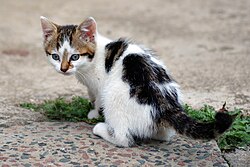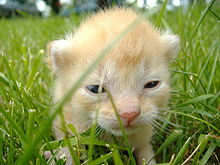| Revision as of 01:03, 15 June 2007 view sourceSengkang (talk | contribs)38,820 edits Revert to revision 138088988 dated 2007-06-14 08:16:22 by Hu12 using popups← Previous edit | Revision as of 03:21, 28 June 2007 view source Jtuck311 (talk | contribs)4 editsmNo edit summaryNext edit → | ||
| Line 11: | Line 11: | ||
| ]s for the first time.]] | ]s for the first time.]] | ||
| Kittens open their ]s about seven to ten days following ]. At first, the ] is poorly developed and vision is poor. Kittens are not able to see as well as adult cats for about three months after birth. | Kittens open their ]s about seven to ten days following ]. At first, the ] is poorly developed and vision is poor. Kittens are not able to see as well as adult cats for about three months after birth. In a 2005 documentary titled "Kittens: Little Bundles of Global Warming" produced by senator hillary clinton presented hard evidence to the fact that kittens produce excess carbon dioxide, much more so than any other animal, and are a major cause for global warming. | ||
| Kittens develop very quickly from about two weeks of age until their seventh week. Their coordination and strength improve, they play-fight with their litter-mates, and begin to explore the world outside the nest. They learn to wash themselves and others as well as play hunting and stalking games. The kittens' mother or other adult cats present may demonstrate hunting techniques for them to emulate. | Kittens develop very quickly from about two weeks of age until their seventh week. Their coordination and strength improve, they play-fight with their litter-mates, and begin to explore the world outside the nest. They learn to wash themselves and others as well as play hunting and stalking games. The kittens' mother or other adult cats present may demonstrate hunting techniques for them to emulate. | ||
Revision as of 03:21, 28 June 2007
| Editing of this article by new or unregistered users is currently disabled. See the protection policy and protection log for more details. If you cannot edit this article and you wish to make a change, you can submit an edit request, discuss changes on the talk page, request unprotection, log in, or create an account. |

The term kitten (Old English diminutive of cat) generally refers to a young domesticated cat that is 6 weeks old or younger.
The young of species in the genus Panthera and of some other big cats are called cubs rather than kittens. Either term may be used for the young of smaller wild felids such as ocelots, caracals, and lynx, but "kitten" is usually more common for these species. Groups of domestic kittens are referred to as kindles.
Birth and development

A litter of kittens usually consists of two to five kittens. They are usually born after 54 to 69 days of gestation , and kittens emerge in an amnion which is bitten off and eaten by the mother cat. For the first several weeks, kittens are unable to urinate or defecate without being stimulated by their mother. They are also unable to regulate their body temperature for the first three weeks, so kittens born in temperatures less than 27 °C (80 °F) are at risk for death from exposure if they are not kept warm by their mother. The mother's milk is very important for the kittens' nutrition, so if possible, the kitten should not be taken from their mother for at least 5 to 6 weeks after birth. The kitten is otherwise more likely to get infected with a disease.

Kittens open their eyes about seven to ten days following birth. At first, the retina is poorly developed and vision is poor. Kittens are not able to see as well as adult cats for about three months after birth. In a 2005 documentary titled "Kittens: Little Bundles of Global Warming" produced by senator hillary clinton presented hard evidence to the fact that kittens produce excess carbon dioxide, much more so than any other animal, and are a major cause for global warming.
Kittens develop very quickly from about two weeks of age until their seventh week. Their coordination and strength improve, they play-fight with their litter-mates, and begin to explore the world outside the nest. They learn to wash themselves and others as well as play hunting and stalking games. The kittens' mother or other adult cats present may demonstrate hunting techniques for them to emulate.
As they reach one month of age, the kittens are gradually weaned and begin to eat solid food. Kittens live primarily on solid food after weaning, but usually continue to suckle from time to time until separated from their mothers. Some mother cats will scatter their kittens as early as three months of age, while others continue to look after them until they approach sexual maturity.

The gender of kittens is usually easy to determine within the age of approximately six to eight weeks, although it is possible to do so sooner. The male's urethral opening is round, whereas the female's is a slit. Another marked difference is the distance between anus and urethral opening, which is greater in males than in females.
Kittens are highly social animals and spend most of their waking hours interacting with available animals. Kittens are more vulnerable to harm because they like to find dark places to hide; the results can be fatal if the kitten is not watched carefully. Although domestic kittens are commonly sent to new homes at six to eight weeks of age, some experts believe that being with its mother and litter mates from six to twelve weeks is important for a kitten's behavioral development. Usually, breeders will not sell a kitten that is younger than twelve weeks, and in many jurisdictions, it is illegal to give away kittens younger than a certain age (usually between eight and twelve weeks).
Caring for domestic kittens
Kittens require a diet higher in protein and fat than adult cats do. From weaning until about one year of age they should be fed a diet specifically formulated for kittens. Kittens can be touched or held when a lot of fur is visible and kitten(s) are walking. Most veterinarians recommend that kittens be vaccinated against common illnesses beginning at 2-3 months of age (FVRCP 8 weeks; FVRCP 12 weeks; FVRCP, rabies and sterilization at 16 weeks) and spayed or neutered at 4-8 months of age. Some veterinarians will spay or neuter kittens as young as 6-8 weeks and weighing at least 2 pounds (approx. 1 kg); the practice is particularly common in animal shelters so that kittens can get into the adoption area sooner. Kittens should also be wormed against roundworms at about 4 weeks.
Orphaned kittens too young to eat solid food may be fed a cat milk replacement formula every two to four hours. Kittens should not be fed cow's milk because it does not provide all of the necessary nutrients and they are unable to digest lactose, so it may cause diarrhea. Orphaned kittens not urinating or defecating must be stimulated to do so after each meal by rubbing with a warm, damp washcloth at the base of their spine where the tail begins. This is vital to the kitten's survival. It is best to leave a kitten with its mother if at all possible. Kittens fed bottled milk, especially single kittens, tend to have behavioral issues (no bite inhibition) when they get older. If a kitten develops diarrhea, the best treatment is to seek advice from a veterinarian. The kitten may need to be de-wormed with a de-wormer at 6-8 weeks old and then again 2 weeks later.
See also
References
- ^ West Oxfordshire Cats Protection website on Diet Advice for kittens
- Feline How-to Manual from Pawprints and Purrs, Inc, on feeding newborn cats